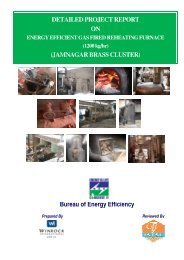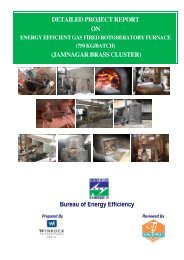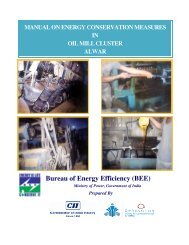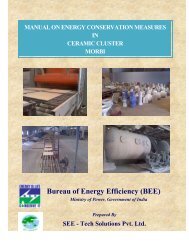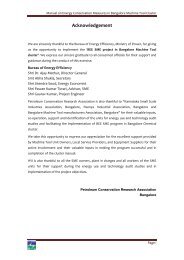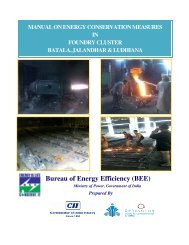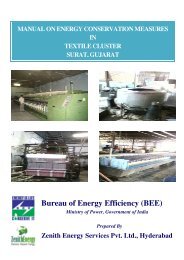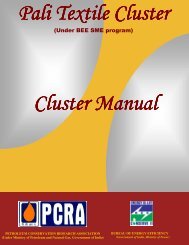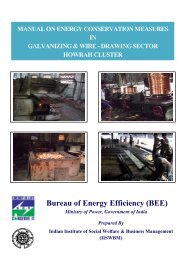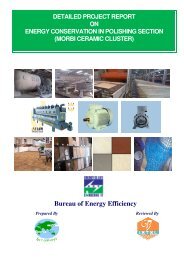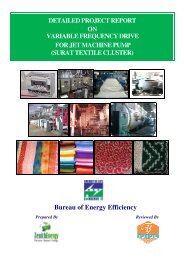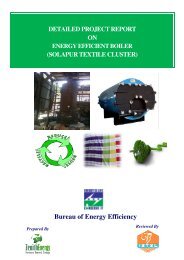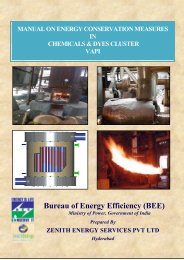1.5 kL - Sameeeksha
1.5 kL - Sameeeksha
1.5 kL - Sameeeksha
Create successful ePaper yourself
Turn your PDF publications into a flip-book with our unique Google optimized e-Paper software.
DETAILED PROJECT REPORT<br />
ON<br />
WASTE HEAT RECOVERY (<strong>1.5</strong> kl/hr)<br />
(SURAT TEXTILE CLUSTER)<br />
Bureau of Energy Efficiency<br />
Prepared By Reviewed By
WASTE HEAT RECOVERY SYSTEM<br />
(<strong>1.5</strong> kl /hr)<br />
SURAT TEXTILE CLUSTER
For more information<br />
Bureau of Energy Efficiency<br />
BEE, 2010<br />
Detailed Project Report on Waste Heat Recovery System<br />
(<strong>1.5</strong> kl /hr)<br />
Ministry of Power, Government of India<br />
4th Floor, Sewa Bhawan, Sector - 1<br />
R. K. Puram, New Delhi -110066<br />
Textile SME Cluster, Surat, Gujrat (India)<br />
New Delhi: Bureau of Energy Efficiency;<br />
Detail Project Report No.: SRT/TXT/WHR/14<br />
Ph: +91 11 26179699 Fax: 11 26178352<br />
Email: jsood@beenet.in<br />
pktiwari@beenet.in<br />
WEB: www.bee-india.nic.in
Acknowledgement<br />
We are sincerely thankful to the Bureau of Energy Efficiency, Ministry of Power, for giving us<br />
the opportunity to implement the ‘BEE SME project in “Surat Textile Cluster, Surat”. We<br />
express our sincere gratitude to all concerned officials for their support and guidance during the<br />
conduct of this exercise.<br />
Dr. Ajay Mathur, Director General, BEE<br />
Smt. Abha Shukla, Secretary, BEE<br />
Shri Jitendra Sood, Energy Economist, BEE<br />
Shri Pawan Kumar Tiwari, Advisor (SME), BEE<br />
Shri Rajeev Yadav, Project Economist, BEE<br />
Zenith Energy Services Pvt. Ltd. is also thankful to “Shri Mahesh Malpani, Chairman, PEPL<br />
and Surat Textile Manufacturers Association” for their valuable inputs, co-operation, support<br />
and identification of the units for energy use and technology audit studies and facilitating the<br />
implementation of BEE SME program in Surat Textile Cluster.<br />
We take this opportunity to express our appreciation for the excellent support provided by<br />
Textile Unit Owners, Local Service Providers, and Equipment Suppliers for their active<br />
involvement and their valuable inputs in making the program successful and in completion of<br />
the Detailed Project Report (DPR).<br />
ZESPL is also thankful to all the SME owners, plant in charges and all workers of the SME<br />
units for their support during the energy use and technology audit studies and in<br />
implementation of the project objectives.<br />
.<br />
Zenith Energy Services Pvt. Ltd.<br />
Hyderabad
Contents<br />
List of Annexure vii<br />
List of Tables vii<br />
List of Figures viii<br />
List of Abbreviation viii<br />
Executive summary ix<br />
About BEE’S SME program x<br />
1 INTRODUCTION .......................................................................................................... 1<br />
1.1 About the Surat textile cluster ....................................................................................... 1<br />
1.1.1 Production process ...................................................................................................... 1<br />
1.2.1 Fuel and electricity consumption of a typical unit .......................................................... 4<br />
1.2.2 Average production by a typical unit in the cluster ........................................................ 4<br />
1.3 Identification of technology/equipment to be upgraded ................................................. 4<br />
1.3.1 Existing/Conventional technology/equipment ............................................................... 4<br />
1.3.2 Role in process ............................................................................................................ 4<br />
1.4 Establishing the baseline .............................................................................................. 5<br />
1.4.1 Design and operating parameters ................................................................................ 5<br />
1.4.2 Quantity of hot drained water ....................................................................................... 5<br />
<strong>1.5</strong> Barriers for proposed energy efficient equipment ......................................................... 5<br />
<strong>1.5</strong>.1 Technological Barriers .................................................................................................. 5<br />
<strong>1.5</strong>.2 Financial Barrier ........................................................................................................... 5<br />
<strong>1.5</strong>.3 Skilled manpower ......................................................................................................... 5<br />
<strong>1.5</strong>.4 Other barrier (If any) ..................................................................................................... 5<br />
2 TECHNOLOGY/EQUIPMENT FOR ENERGY EFFICIENCY IMPROVEMENTS .......... 6<br />
2.1 Detailed description of equipment selected .................................................................. 6<br />
2.1.1 Description of equipment .............................................................................................. 6<br />
2.1.2 Equipment specifications .............................................................................................. 6<br />
2.1.3 Integration of equipment with existing equipment ......................................................... 6<br />
2.1.4 Superiority over existing technology/equipment ............................................................ 6
2.<strong>1.5</strong> Availability of the proposed equipment ......................................................................... 7<br />
2.1.6 Source of technology/equipment for the project ............................................................ 7<br />
2.1.7 Service/technology providers ....................................................................................... 7<br />
2.1.8 Terms and condition in sales of equipment. ................................................................. 7<br />
2.1.9 Process down time during implementation ................................................................... 7<br />
2.2 Life cycle assessment and risks analysis ..................................................................... 7<br />
2.3 Suitable unit for implementation of proposed equipment .............................................. 7<br />
3 ECONOMIC BENEFITS OF PROPOSED EQUIPMENT .............................................. 8<br />
3.1 Technical benefits ........................................................................................................ 8<br />
3.1.1 Fuel saving ................................................................................................................... 8<br />
3.1.2 Electricity saving .......................................................................................................... 8<br />
3.1.3 Improvement in product quality .................................................................................... 8<br />
3.1.4 Increase in production .................................................................................................. 8<br />
3.<strong>1.5</strong> Reduction in raw material consumption ........................................................................ 8<br />
3.1.6 Reduction in other losses ............................................................................................. 8<br />
3.2 Monetary benefits ......................................................................................................... 8<br />
3.3 Social benefits .............................................................................................................. 9<br />
3.3.1 Improvement in working environment in the plant ......................................................... 9<br />
3.3.2 Improvement in skill set of workers ............................................................................... 9<br />
3.4 Environmental benefits ................................................................................................. 9<br />
3.4.1 Reduction in effluent generation ................................................................................... 9<br />
3.4.2 Reduction in GHG emission ......................................................................................... 9<br />
3.4.3 Reduction in other emissions like SOx .......................................................................... 9<br />
4 IMPLEMENTATION OF PROPOSED EQUIPMENT .................................................. 10<br />
4.1 Cost of equipment implementation ............................................................................. 10<br />
4.1.1 Cost of equipment ...................................................................................................... 10<br />
4.1.2 Other costs ................................................................................................................. 10<br />
4.2 Arrangement of funds ................................................................................................. 10<br />
4.2.1 Entrepreneur’s contribution ........................................................................................ 10
4.2.2 Loan amount .............................................................................................................. 10<br />
4.2.3 Terms & conditions of loan ......................................................................................... 10<br />
4.3 Financial indicators .................................................................................................... 10<br />
4.3.1 Cash flow analysis ..................................................................................................... 10<br />
4.3.2 Simple payback period ............................................................................................... 11<br />
4.3.3 Net Present Value (NPV) ........................................................................................... 11<br />
4.3.4 Internal rate of return (IRR) ........................................................................................ 11<br />
4.3.5 Return on investment (ROI) ........................................................................................ 11<br />
4.4 Sensitivity analysis in realistic, pessimistic and optimistic scenarios ........................... 11<br />
4.5 Procurement and implementation schedule ................................................................ 12
List of Annexure<br />
Annexure 1 Energy audit report for baseline establishment ..............................................13<br />
Annexure 2 Process flow diagram ....................................................................................14<br />
Annexure 3 Technology Assessment Report – Waste Heat Recovery System .................15<br />
Annexure 4 Drawings of proposed equipment ..................................................................16<br />
Annexure 5 Detailed financial calculations & analysis ......................................................18<br />
Annexure 6 Procurement and Implementation plan schedule ...........................................22<br />
Annexure 7 Details of equipment and service providers ...................................................23<br />
Annexure 8 Quotations or Techno-commercial bids for proposed equipment ...................24<br />
List of Tables<br />
Table 1.1: Energy consumption of a typical unit ................................................................ 4<br />
Table 1.2 Quantity of hot drained water of typical units ..................................................... 5<br />
Table 3.1 Energy and Monetary Benefit due to Project Implementation............................. 8<br />
Table 4.1 Details of Proposed Equipment Installation Cost ..............................................10<br />
Table 4.2 Sensitivity analysis at different scenarios ..........................................................11<br />
List of Figures<br />
Figure 1.1 Process Flowchart of Surat Textile Cluster ....................................................... 3<br />
vii
List of Abbreviations<br />
kWh kilo Watt Hour<br />
CETP Common Effluent Treatment Plant<br />
SME Small and Medium Enterprises<br />
GHG Green House Gas<br />
BEE Bureau of Energy Efficiency<br />
DPR Detailed Project Report<br />
O&M Operational & Maintenance<br />
NPV Net Present Values<br />
ROI Return on Investment<br />
IRR Internal Rate of Return<br />
DSCR Debt Service Coverage Ratio<br />
PBT Profit Before Tax<br />
PAT Profit After Tax<br />
SIDBI Small Industries Development of India<br />
WHR Waste Heat Recovery<br />
WHRS Waste Heat Recovery System<br />
MoMSME Ministry of Micro Small and Medium Enterprises<br />
viii
EXECUTIVE SUMMARY<br />
Zenith Energy Services Pvt. Ltd is executing BEE-SME program in Surat textile cluster,<br />
supported by Bureau of Energy Efficiency (BEE) with an overall objective of improving<br />
the energy efficiency in cluster units.<br />
Surat textile cluster is one of the largest textile clusters in India; accordingly this cluster<br />
was chosen for energy efficiency improvements by implementing energy efficient<br />
measures/technologies, so as to facilitate maximum replication in other textile clusters<br />
in India.<br />
The main energy forms used in the cluster units are electricity and fuel such as wood,<br />
coal, natural gas and other biomass product. Mostly used in boilers, thermopac, Jet<br />
dying, stenter, loop machine, scouring, bleaching, Jiggers, Jumbo, hydro extractor,<br />
small pumps and lighting.<br />
Installation of Waste Heat Recovery System with Jet dying machine or Jigger or Jumbo<br />
will reduces fossil fuel consumption & production cost and also reduces the<br />
environmentally harmful green house gases emission.<br />
Project implementation i.e. installation of waste heat recovery system will lead to<br />
reduction in fuel consumption by 97 tonne per annum however; this intervention will not<br />
have any effect on the existing consumption pattern of electricity fuel.<br />
This bankable DPR also found eligible for subsidy scheme of MoMSME for<br />
“Technology and Quality Upgradation Support to Micro, Small and Medium<br />
Enterprises” under “National Manufacturing and Competitiveness Programme”. The<br />
key indicators of the DPR including the Project cost, debt equity ratio, monetary benefit<br />
and other necessary parameters are given in table:<br />
S.No Particular Unit Value<br />
1 Project cost `(in lakh) 3.11<br />
2 Fuel saving tonne / year 89<br />
3 Monetary benefit `(in lakh) 3.38<br />
4 Debit equity ratio ratio 3:1<br />
5 Simple payback period years 1.08<br />
6 NPV `(in lakh) 9.42<br />
7 IRR %age 84.28<br />
8 ROI %age 29.00<br />
9 DSCR ratio 4.47<br />
10 Process down time day 10<br />
The projected profitability and cash flow statements indicate that the project<br />
implementation will be financially viable and technically feasible<br />
ix
ABOUT BEE’S SME PROGRAM<br />
Bureau of Energy Efficiency (BEE) is implementing a BEE-SME Programme to<br />
improve the energy performance in 25 selected SMEs clusters. Surat Textile Cluster is<br />
one of them. The BEE’s SME Programme intends to enhance the energy efficiency<br />
awareness by funding / subsidizing need based studies in SME clusters and giving<br />
energy conservation recommendations. For addressing the specific problems of these<br />
SMEs and enhancing energy efficiency in the clusters, BEE will be focusing on energy<br />
efficiency, energy conservation and technology up-gradation through studies and pilot<br />
projects in these SMEs clusters.<br />
Major activities in the BEE -SME program are furnished below:<br />
Energy use and technology audit<br />
The energy use technology studies would provide information on technology status,<br />
best operating practices, gaps in skills and knowledge on energy conservation<br />
opportunities, energy saving potential and new energy efficient technologies, etc for<br />
each of the sub sector in SMEs.<br />
Capacity building of stake holders in cluster on energy efficiency<br />
In most of the cases SME entrepreneurs are dependent on the locally available<br />
technologies, service providers for various reasons. To address this issue BEE has<br />
also undertaken capacity building of local service providers and entrepreneurs/<br />
Managers of SMEs on energy efficiency improvement in their units as well as clusters.<br />
The local service providers will be trained in order to be able to provide the local<br />
services in setting up energy efficiency projects in the clusters<br />
Implementation of energy efficiency measures<br />
To implement the technology up-gradation projects in clusters, BEE have proposed to<br />
prepare the technology based detailed project reports (DPRs) for a minimum of five<br />
technologies in three capacities for each technology.<br />
Facilitation of innovative financing mechanisms for implementation of energy<br />
efficiency projects<br />
The objective of this activity is to facilitate the uptake of energy efficiency measures<br />
through innovative financing mechanisms without creating market distortion<br />
x
1 INTRODUCTION<br />
1.1 About the Surat textile cluster<br />
Waste Heat Recovery (<strong>1.5</strong> kl/hour)<br />
The products manufactured in Surat Textile Cluster are synthetic sarees and dress<br />
materials and the products are renowned in the country and abroad. The main raw<br />
material for the cluster units is grey cloth and is procured from local weaving units and<br />
agents. The cost of energy (electrical and thermal energy) as percentage of<br />
manufacturing cost varies between 12 and 15%.<br />
Majority of the cluster units are of integrated type, where the raw material “grey cloth”<br />
is processed in-house to the final product like sarees and dress materials. Most of the<br />
units of the cluster are working on Job basis, where the textile agents will provide<br />
design and grey cloth and the unit’s process as per design provided by the clients. The<br />
energy cost is next to the raw materials cost.<br />
1.1.1 Production process<br />
The main process operation for dyeing and printing process of synthetic sarees and<br />
dress materials adopted in cluster units are as follows:<br />
Fabric pre-treatment<br />
The main purpose of the fabric pre-treatment process is to remove oil, grease and<br />
other materials and to whiten the grey cloth though bleaching. The various process<br />
adopted in pre-treatment are scouring, bleaching and shrinking process.<br />
Dyeing<br />
Dyeing is the process of imparting colors to the material through a dye (color). In which<br />
a dye is applied to the substrate in a uniform manner to obtain an even shade with a<br />
performance and fastness appropriate to its final use. This process is mainly performed<br />
in Jet Dyeing Machines and Jigger machines.<br />
Dyeing of fabric is carried out in jet dyeing machines. The temperature of the solution<br />
is raised to 50°C. Concentrated dyestuff solution is prepared separately and is added<br />
to the liquor. After the addition of dyes, the temperature is raised to 130°C and<br />
maintained for about 60 minutes.<br />
After whitening/dyeing, the fabric is unloaded from the machine and taken to the<br />
folding and rolling machines for improving the width of cloth, which gets shrunk during<br />
the washing and dyeing process.<br />
Printing<br />
In Surat cluster three types printing methods are used. Most of the units are use flat<br />
bed printing, rotary printing and some units follows hand printing. Hand printing is the<br />
1
Waste Heat Recovery (<strong>1.5</strong> kl/hour)<br />
old method to print the fabric. The flat bed printing has provision for printing 10 to 14<br />
colors simultaneously. The color print paste prepared is fed onto the screens from<br />
which it is transferred to the fabric fed in. The fabric after print paste transfer is passed<br />
through a drying chamber at 145°C. The dried and printed fabric is taken for further<br />
processing.<br />
Drying and Finishing<br />
After printing, the drying process is performed in loop machine, where the temperature<br />
is maintained between 130°C to 170°C for better colour setting. After passing through<br />
the loop machines, the printed fabric is washed in a series of normal water and hot<br />
water washing in the presence of chemicals for colour setting. After completion of the<br />
washing process, the printed and washed fabric is subjected to heat setting process in<br />
Stenter and then pressing and finishing treatments.<br />
2
Gray (Raw Material)<br />
Scouring (Soflina)<br />
Shrinking & Bleaching<br />
(Drum Washer)<br />
Dyeing & Washing (Jet<br />
Dyeing)<br />
Heat Setting (Stenter)<br />
Printing<br />
Colour Setting (Loop<br />
Machine)<br />
Hydro Extraction<br />
Heat Setting (Stenter)<br />
Pressing<br />
Packing/Dispatch<br />
Waste Heat Recovery (<strong>1.5</strong> kl/hour)<br />
Grey (Raw Material)<br />
Scouring (Soflina)<br />
Shrinking & Bleaching<br />
(Drum Washer)<br />
Dyeing & Washing Jet<br />
Dyeing)<br />
Heat Setting<br />
(Stenter)<br />
Printing<br />
Colour Setting<br />
(Loop Machine)<br />
Hydro Extraction<br />
Heat Setting (Stenter)<br />
Pressing<br />
Packing/Dispatch<br />
Figure 1.1 Process Flowchart of Surat Textile Cluster<br />
3
1.2 Energy performance in existing situation<br />
1.2.1 Fuel and electricity consumption of a typical unit<br />
Waste Heat Recovery (<strong>1.5</strong> kl/hour)<br />
The main energy forms used in a typical unit in the cluster are electricity, coal/lignite<br />
and natural gas. Electricity is used for driving the prime movers of pumps, fans, stenter<br />
fans, ID and FD fans, conveyers, loop machines drives, lighting etc. Imported coal and<br />
lignite are used as fuel in boilers for steam generation and whereas natural gas is used<br />
as fuel in generators for electricity generation, stenters, printing and loop machines.<br />
The energy consumption of a typical unit in the cluster using local make pumps and<br />
having about 15 Jet machines is furnished in Table 1.1 below:<br />
Table 1.1: Energy consumption of a typical unit<br />
S.No Details Unit Value<br />
1 Coal/lignite consumption tonne/year 1987<br />
2 Grid electricity consumption MWh/annum 751<br />
3 Natural gas consumption million SCM/year 0.216<br />
4 Production (quantity processed) meter(In lakh)/year 175<br />
1.2.2 Average production by a typical unit in the cluster<br />
The average production in a year in a typical unit is 175 lakh meters of final product.<br />
1.3 Identification of technology/equipment to be upgraded<br />
1.3.1 Existing/Conventional technology/equipment<br />
There are 8 jet machines of various capacities ranging from 50 to 200 kg and all the jet<br />
machines are operated continuously for 24 hours in a day. At present, the drained hot<br />
water from the jet machines is drained to the CETP (Common Effluent Treatment<br />
Plant) at 90 oC without any heat recovery leading to wasteful of energy.<br />
1.3.2 Role in process<br />
The project activity is installation of waste heat recovery system (WHRS) and is<br />
additional equipment consists of heat exchangers, pipe lines, water tanks, valves for<br />
controlling the flow etc<br />
4
1.4 Establishing the baseline<br />
1.4.1 Design and operating parameters<br />
Waste Heat Recovery (<strong>1.5</strong> kl/hour)<br />
About 31 kilolitres of hot water at 90 o C is drained to the CETP from all the jet<br />
machines in a day for typical unit having production capacity of 50,000 meters/day<br />
1.4.2 Quantity of hot drained water<br />
The drained water quantity of various jet machines of three cluster units and is<br />
furnished in Table 1.2 below<br />
Table 1.2 Quantity of hot drained water of typical units<br />
S. No Name of the unit<br />
No. Jet Machines<br />
Capacity (nos)<br />
Hot Water Drained<br />
(kl/day)<br />
1 Vitrag silk mills Pvt Ltd 8 31<br />
2 Trishla silk mills Pvt Ltd<br />
3 Tulsi Syntex Pvt Ltd<br />
6 (5 Jet machines & 2<br />
drum machines)<br />
6 Jet machines & 5 drum<br />
machines<br />
<strong>1.5</strong> Barriers for proposed energy efficient equipment<br />
<strong>1.5</strong>.1 Technological Barriers<br />
The major technical barriers that prevented the implementation of the waste heat<br />
recovery system in the cluster are:<br />
• Lack of awareness of the technology<br />
• Dependence on local equipment suppliers, who doesn’t have technical<br />
knowledge<br />
<strong>1.5</strong>.2 Financial Barrier<br />
The lack of awareness of the losses and monetary benefit<br />
<strong>1.5</strong>.3 Skilled manpower<br />
One local technical persons available at Surat takes care of about 5-10 textile units.<br />
Maintenance or repair work of major equipments of textile units like stenter, Jet Dyeing<br />
machine, Jigger machine etc, are generally taken care by the equipment suppliers<br />
itself.<br />
<strong>1.5</strong>.4 Other barrier (If any)<br />
Space availability for laying pipe lines and water storage tanks<br />
36<br />
32<br />
5
Waste Heat Recovery (<strong>1.5</strong> kl/hour)<br />
2 TECHNOLOGY/EQUIPMENT FOR ENERGY EFFICIENCY IMPROVEMENTS<br />
2.1 Detailed description of equipment selected<br />
2.1.1 Description of equipment<br />
The purpose of the waste heat recovery system consists of heat exchangers, hot and<br />
cold water tanks, pump for circulating water and distribution system. The drained water<br />
from jet machines is passed through one side of the shell and tube heat exchanger and<br />
cold water to be heated on other side. The drained water after recovering the heat is<br />
drained to the CETP. The hot fresh water is stored in the tank and is supplied to<br />
different sections of the plant.<br />
The shell contains the tube bundles, and internal baffles, to direct the fluid in the shell<br />
over the tubes in two or multi pass system. The heat exchanger consists of series of<br />
tubes, where the jet machine drained hot water is passed through the tubes and fresh<br />
water to be heated in the shell and heat is absorbed by the water and can be used for<br />
the process requirement or can be used as boiler feed water.<br />
2.1.2 Equipment specifications<br />
The detailed drawing has been provided in the Annexure 4 as the equipment is<br />
fabricated and hence technical specifications were not provided.<br />
2.1.3 Integration of equipment with existing equipment<br />
The jet machines are the most commonly found equipment in the cluster units and<br />
considerable quantities of hot water is required and coloured water after dyeing<br />
process is completed drained and the temperature is found to be 90 0 C. The studies<br />
were carried out in 75 industries, and all the units are draining hot water without any<br />
heat recovery.<br />
Installing waste heat recovery system for recovering heat from the drained water for<br />
hot water generation will reduce the fuel consumption and generated hot water can be<br />
used in the process or as boiler feed water and hence reduces coal consumption.<br />
2.1.4 Superiority over existing technology/equipment<br />
• The proposed technology enhances the efficiency for the following reasons:<br />
• The precious heat available in the drained hot water is utilized and hence<br />
reduces coal consumption<br />
• The system will also reduce the process time<br />
• By heating the water it is also helping to prevent thermal shock in boilers as<br />
reduces the load on the equipments<br />
6
2.<strong>1.5</strong> Availability of the proposed equipment<br />
The proposed equipment is locally available.<br />
2.1.6 Source of technology/equipment for the project<br />
Waste Heat Recovery (<strong>1.5</strong> kl/hour)<br />
The technology is indigenously developed and this technology is adopted from the<br />
exhaust gases recovery through economizer.<br />
2.1.7 Service/technology providers<br />
The service providers are locally available and contact details of service providers are<br />
given in Annexure 7.<br />
2.1.8 Terms and condition in sales of equipment.<br />
The terms of sales of the equipment supplier are:<br />
• 50% advance along with the order<br />
• 50% against Performa invoice prior to dispatch<br />
2.1.9 Process down time during implementation<br />
The detail of process down time is provided in Annexure 6.<br />
2.2 Life cycle assessment and risks analysis<br />
The operational life of the proposed economizer is 15 years and no majors risks are<br />
identified, as the proposed equipment is additional to the existing system.<br />
2.3 Suitable unit for implementation of proposed equipment<br />
The waste heat recovery is designed such that the maximum amount of heat available<br />
in the hot drained water is recovered and suitable for all the unit where about 31000<br />
liter hot water is drained per day.<br />
7
3 ECONOMIC BENEFITS OF PROPOSED EQUIPMENT<br />
3.1 Technical benefits<br />
3.1.1 Fuel saving<br />
Waste Heat Recovery (<strong>1.5</strong> kl/hour)<br />
The equivalent imported coal savings due to implementation of the waste heat<br />
recovery system for hot water generation is estimated at 89 tonne per annum. A Detail<br />
saving calculation is presented at Annexure1.<br />
3.1.2 Electricity saving<br />
The electricity consumption is increase due to installation of small motor pump to<br />
circulate the water but it is negligible with the total electricity consumption hence no<br />
electrical savings is envisaged.<br />
3.1.3 Improvement in product quality<br />
There is no significant impact on product quality directly or indirectly.<br />
3.1.4 Increase in production<br />
As the hot water is generated by utilizing the waste heat available in the drained hot<br />
water and can be directly used for the process, hence, production may increase.<br />
3.<strong>1.5</strong> Reduction in raw material consumption<br />
No significant impact on raw materials consumption directly or indirectly.<br />
3.1.6 Reduction in other losses<br />
There is no significant reduction in other looses directly or indirectly.<br />
3.2 Monetary benefits<br />
The monetary benefit by implementation of the waste heat recovery system is<br />
estimated as ` 3.38 lakh per annum due to reduction in coal consumption. Energy &<br />
monetary benefit analysis of waste heat recovery system are shown in Table 3.1 below<br />
Table 3.1 Energy and Monetary Benefit due to Project Implementation<br />
S. No. Particulars Unit Value<br />
1 Quantity of drained hot water available liters/day 31000<br />
2 Average quantity per day (80%) liters/day 24800<br />
3 Temperature of hot drain water 0 C 90<br />
4 Temperature of hot drain water after WHR 0 C 50<br />
5 Quantity of heat can be recovered kCal/day 992000<br />
6 Present Boiler efficiency % 65<br />
8
Waste Heat Recovery (<strong>1.5</strong> kl/hour)<br />
S. No. Particulars Unit Value<br />
7 Calorific value of fuel kCal/kg 6000<br />
8 Fuel saving per annum Tonne/annum 89<br />
9 Cost of fuel `/fuel 3800<br />
10 Saving in rupees ` (lakh) /year 3.38<br />
3.3 Social benefits<br />
3.3.1 Improvement in working environment in the plant<br />
The project activity identified will utilize state-of-the-art technologies to ensure energy<br />
efficiency and energy conservation of non renewable fuels and the project activity<br />
reduce drained water temperature and hence improves working environment<br />
3.3.2 Improvement in skill set of workers<br />
The equipment selected for the implementation is new and energy efficient. The<br />
equipment implemented will create awareness among the workforce and improves the<br />
skill of the workers.<br />
3.4 Environmental benefits<br />
3.4.1 Reduction in effluent generation<br />
There is no significant impact in effluent generation due to implementation of the<br />
project activity.<br />
3.4.2 Reduction in GHG emission<br />
The major GHG emission reduction source is CO2. The technology will reduce fossil<br />
fuel consumption due to waste heat recovery of the waste drained water. The total<br />
emission reductions are estimated at 64 tonnes of CO2 per annum due to<br />
implementation of the project activity.<br />
3.4.3 Reduction in other emissions like SOx<br />
The equipment reduces the coal consumption and also reduces SOx emissions.<br />
9
4 IMPLEMENTATION OF PROPOSED EQUIPMENT<br />
4.1 Cost of equipment implementation<br />
4.1.1 Cost of equipment<br />
Waste Heat Recovery (<strong>1.5</strong> kl/hour)<br />
The total cost of system is estimated at ` 3.00 lakh, which includes heat exchanger,<br />
hot and cold water tanks, water distribution lines, pump for water circulation etc.<br />
4.1.2 Other costs<br />
The total cost of implementation of the waste heat recovery is estimated at ` 3.11 lakh.<br />
The above cost includes cost of equipment / machinery, cost of fabrication (and/or)<br />
commissioning charges and the details are furnished below;<br />
4.2 Arrangement of funds<br />
Table 4.1 Details of Proposed Equipment Installation Cost<br />
S. No Particulars Unit Cost<br />
1 Equipment Cost ` (In Lakh) 3.00<br />
2 Erection & commissioning cost ` (In Lakh) 0.11<br />
3 Interest during Implementation ` (In Lakh) 0.00<br />
4 Total Cost ` (In Lakh) 3.11<br />
4.2.1 Entrepreneur’s contribution<br />
The entrepreneur’s contribution is 25% of total project cost, which works out at ` 0.78<br />
lakh.<br />
4.2.2 Loan amount<br />
The term loan is 75% of the total project, which is ` 2.33 lakh.<br />
4.2.3 Terms & conditions of loan<br />
The interest rate is considered at 10% which is SIDBI’s rate of interest for energy<br />
efficient projects. The loan tenure is 5 years excluding initial moratorium period is 6<br />
months from the date of first disbursement of loan.<br />
4.3 Financial indicators<br />
4.3.1 Cash flow analysis<br />
Considering the above discussed assumptions, the net cash accruals starting with<br />
` 2.74 lakh in the first year operation gradually increases to ` 15.21 lakh at the end of<br />
eighth year.<br />
10
4.3.2 Simple payback period<br />
Waste Heat Recovery (<strong>1.5</strong> kl/hour)<br />
The total project cost of the proposed technology is ` 3.11 lakh and monetary savings<br />
due to reduction in coal consumption is ` 3.38 lakh and the simple payback period<br />
works out to be 13 months.<br />
4.3.3 Net Present Value (NPV)<br />
The Net present value of the investment at 10.00% interest rate works out to be ` 9.42<br />
lakh.<br />
4.3.4 Internal rate of return (IRR)<br />
The after tax Internal Rate of Return of the project works out to be 84.28%. Thus the<br />
project is financially viable.<br />
4.3.5 Return on investment (ROI)<br />
The average return on investment of the project activity works out at 29.00% for an<br />
investment of ` 3.11 lakh. The average debt service coverage ratio works out at 4.47.<br />
4.4 Sensitivity analysis in realistic, pessimistic and optimistic scenarios<br />
A sensitivity analysis has been worked out to ascertain how the project financials<br />
would behave in different situations like there is an increase in fuel savings or<br />
decrease in fuel savings. For the purpose of sensitive analysis, two scenarios are<br />
considered are.<br />
• Increase in fuel savings by 5%<br />
• Decrease in fuel savings by 5%<br />
In each scenario, other inputs are assumed as constant. The financial indicators in<br />
each of the above situation are indicated along with standard indicators are shown in<br />
Table 4.2 below:<br />
Table 4.2 Sensitivity analysis at different scenarios<br />
Particulars IRR NPV ROI DSCR<br />
Normal 84.28 9.42 29.00 4.47<br />
5% decrease in fuel savings 80.26 8.82 28.76 4.26<br />
5% increase in fuel savings 88.26 10.01 29.22 4.68<br />
The project is highly sensitive to fuel savings, the debt service coverage ratio works out<br />
to be 4.26 times in worst scenario, which indicates the strength of the project.<br />
11
4.5 Procurement and implementation schedule<br />
Waste Heat Recovery (<strong>1.5</strong> kl/hour)<br />
The project is expected to be completed in 10 weeks from the date of financial closure.<br />
The detailed schedule of project implementation is furnished in Annexure 7.<br />
12
Annexure 1 Energy audit report for baseline establishment<br />
Waste Heat Recovery (<strong>1.5</strong> kl/hour)<br />
Annexure<br />
S No Parameter Units Details<br />
1 Quantity of hot water drained available liters/day 31000<br />
2. Average quantity per day (80%) liters/day 24800<br />
3. Temperature of hot drain water 0 C 90<br />
4 Quantity of heat can be recovered kCal/day 992000<br />
5 Present Boiler efficiency %age 65<br />
6 Calorific value of fuel kCal/kg 6000<br />
7 Fuel savings per day kg/day 254<br />
8 Operating days per annum days 350<br />
9 Fuel saving per annum Tonne/annum 89<br />
10 Fuel cost `/tonne 3800<br />
11 Monetary savings per annum `In lakh 3.38<br />
12<br />
Investment for tank, heat exchanger and<br />
pumping system<br />
` In lakh 3.11<br />
13 Payback period Year 1.08<br />
13
Annexure 2 Process flow diagram<br />
Waste Heat Recovery (<strong>1.5</strong> kl/hour)<br />
14
Waste Heat Recovery (<strong>1.5</strong> kl/hour)<br />
Annexure 3 Technology Assessment Report – Waste Heat Recovery System<br />
The jet machines are the most commonly found equipment in the cluster units and<br />
considerable quantities of hot water is required and colored water after dyeing process<br />
is completed drained and the temperature is found to be 90 0 C. The studies were<br />
carried out in 75 industries, and all the units are draining hot water without any heat<br />
recovery.<br />
Installing waste heat recovery system for recovering heat from the drained water for<br />
hot water generation will reduce the fuel consumption and hot water generated can be<br />
used in the process or as boiler feed water and hence reduces coal consumption<br />
The proposed technology enhances the efficiency for the following reasons:<br />
The precious heat available in the hot drained water is utilized and thus reduces coal<br />
consumption<br />
The system will reduce the process time<br />
By heating the water it is also helping to prevent thermal shock in boilers as reduces<br />
the load on the equipments<br />
Reduces thermal pollutants to the atmosphere due to reduction in coal consumption<br />
Basis for Selection of Equipment<br />
The various factors influence the selection and sizing of the waste heat recovery<br />
system. The following were considered:<br />
- Quantity of heat available in hot drained water<br />
- Temperature of hot water required for the process and other allied applications<br />
- Space availability<br />
- Cost economics<br />
15
Annexure 4 Drawings of proposed equipment<br />
Waste Heat Recovery (<strong>1.5</strong> kl/hour)<br />
16
Schematic diagram of waste heat recovery system<br />
Waste Heat Recovery (<strong>1.5</strong> kl/hour)<br />
17
Annexure 5 Detailed financial calculations & analysis<br />
Waste Heat Recovery (<strong>1.5</strong> kl/hour)<br />
Assumption<br />
Name of the Technology Waste Heat Recovery System from hot drained water<br />
Rated Capacity <strong>1.5</strong> kl/hr<br />
Details Unit Value Basis<br />
Installed Capacity Kl/hr <strong>1.5</strong><br />
No of working days Days 350<br />
No of Shifts per day Shifts 3<br />
Proposed Investment<br />
Plant & Machinery ` (in lakh) 3.00<br />
Erection & Commissioning ` (in lakh) 0.11<br />
Total Investment ` (in lakh) 3.11<br />
Financing pattern<br />
Own Funds (Equity) ` (in lakh) 0.78 Feasibility Study<br />
Loan Funds (Term Loan) ` (in lakh) 2.33 Feasibility Study<br />
Loan Tenure years 5 Assumed<br />
Moratorium Period Months 6 Assumed<br />
Repayment Period Months 66 Assumed<br />
Interest Rate % 10.00 SIDBI Lending rate<br />
Estimation of Costs<br />
O & M Costs % on Plant & Equip 4.00 Feasibility Study<br />
Annual Escalation % 5.00 Feasibility Study<br />
Estimation of Revenue<br />
Coal Saving Tons 89<br />
Cost `/Tons 3800<br />
St. line Depn. %age 5.28 Indian Companies Act<br />
IT Depreciation %age 80.00 Income Tax Rules<br />
Income Tax %age 33.99 Income Tax<br />
Estimation of Interest on Term Loan (```` in lakh)<br />
Years Opening Balance Repayment Closing Balance Interest<br />
1 2.33 0.12 2.21 0.21<br />
2 2.21 0.24 1.97 0.21<br />
3 1.97 0.38 <strong>1.5</strong>9 0.19<br />
4 <strong>1.5</strong>9 0.55 1.04 0.14<br />
5 1.04 0.72 0.32 0.07<br />
6 0.32 0.32 0.00 0.01<br />
2.33<br />
WDV Depreciation<br />
Particulars / years 1 2<br />
Plant and Machinery<br />
Cost 3.11 0.62<br />
Depreciation 2.49 0.50<br />
WDV 0.62 0.12<br />
18
Waste Heat Recovery (<strong>1.5</strong> kl/hour)<br />
Projected Profitability<br />
Particulars / Years 1 2 3 4 5 6 7 8<br />
Revenue through Savings<br />
Fuel savings 3.38 3.38 3.38 3.38 3.38 3.38 3.38 3.38<br />
Total Revenue (A) 3.38 3.38 3.38 3.38 3.38 3.38 3.38 3.38<br />
Expenses<br />
O & M Expenses 0.12 0.13 0.14 0.14 0.15 0.16 0.17 0.18<br />
Total Expenses (B) 0.12 0.13 0.14 0.14 0.15 0.16 0.17 0.18<br />
PBDIT (A)-(B) 3.26 3.25 3.24 3.24 3.23 3.22 3.22 3.21<br />
Interest 0.21 0.21 0.19 0.14 0.07 0.01 - -<br />
PBDT 3.05 3.04 3.06 3.10 3.16 3.21 3.22 3.21<br />
Depreciation 0.16 0.16 0.16 0.16 0.16 0.16 0.16 0.16<br />
PBT 2.88 2.88 2.89 2.94 2.99 3.05 3.05 3.04<br />
Income tax 0.19 0.86 1.04 1.05 1.07 1.09 1.09 1.09<br />
Profit after tax (PAT) 2.69 2.01 1.85 1.88 1.92 1.96 1.96 1.95<br />
Computation of Tax ```` (in lakh)<br />
Particulars / Years 1 2 3 4 5 6 7 8<br />
Profit before tax 2.88 2.88 2.89 2.94 2.99 3.05 3.05 3.04<br />
Add: Book depreciation 0.16 0.16 0.16 0.16 0.16 0.16 0.16 0.16<br />
Less: WDV depreciation 2.49 0.50 - - - - - -<br />
Taxable profit 0.56 2.54 3.06 3.10 3.16 3.21 3.22 3.21<br />
Income Tax 0.19 0.86 1.04 1.05 1.07 1.09 1.09 1.09<br />
Projected Balance Sheet<br />
```` (in lakh)<br />
Particulars / Years 1 2 3 4 5 6 7 8<br />
Liabilities<br />
Share Capital (D) 0.78 0.78 0.78 0.78 0.78 0.78 0.78 0.78<br />
Reserves & Surplus (E) 2.69 4.70 6.56 8.44 10.36 12.32 14.28 16.23<br />
Term Loans (F) 2.21 1.97 <strong>1.5</strong>9 1.04 0.32 0.00 0.00 0.00<br />
Total Liabilities D)+(E)+(F) 5.68 7.46 8.93 10.26 11.46 13.10 15.05 17.01<br />
Assets<br />
Gross Fixed Assets 3.11 3.11 3.11 3.11 3.11 3.11 3.11 3.11<br />
Less: Accm. Depreciation 0.16 0.33 0.49 0.66 0.82 0.99 1.15 1.31<br />
Net Fixed Assets 2.95 2.78 2.62 2.45 2.29 2.13 1.96 1.80<br />
Cash & Bank Balance 2.74 4.67 6.31 7.81 9.17 10.97 13.09 15.21<br />
Total Assets 5.68 7.46 8.93 10.26 11.46 13.10 15.05 17.01<br />
Net Worth 3.47 5.48 7.34 9.22 11.14 13.10 15.05 17.01<br />
Dept equity ratio 2.85 2.54 2.05 1.34 0.42 0.00 0.00 0.00<br />
Projected Cash Flow: ` ` ` ` (in lakh)<br />
Particulars / Years 0 1 2 3 4 5 6 7 8<br />
Sources<br />
Share Capital 0.78 - - - - - - - -<br />
Term Loan 2.33<br />
Profit After tax 2.69 2.01 1.85 1.88 1.92 1.96 1.96 1.95<br />
Depreciation 0.16 0.16 0.16 0.16 0.16 0.16 0.16 0.16<br />
Total Sources 3.11 2.86 2.18 2.02 2.05 2.08 2.12 2.12 2.12<br />
Application<br />
19
Waste Heat Recovery (<strong>1.5</strong> kl/hour)<br />
Capital Expenditure 3.11<br />
Repayment of Loan - 0.12 0.24 0.38 0.55 0.72 0.32 - -<br />
Total Application 3.11 0.12 0.24 0.38 0.55 0.72 0.32 - -<br />
Net Surplus - 2.74 1.94 1.64 <strong>1.5</strong>0 1.36 1.80 2.12 2.12<br />
Add: Opening Balance - - 2.74 4.67 6.31 7.81 9.17 10.97 13.09<br />
losing Balance - 2.74 4.67 6.31 7.81 9.17 10.97 13.09 15.21<br />
Calculation of Internal Rate of Return<br />
` ` ` ` (in lakh)<br />
Particulars / months 0 1 2 3 4 5 6 7 8<br />
Profit after Tax 2.69 2.01 1.85 1.88 1.92 1.96 1.96 1.95<br />
Depreciation<br />
Interest on Term<br />
0.16 0.16 0.16 0.16 0.16 0.16 0.16 0.16<br />
Loan<br />
Salvage/Realizable<br />
0.21 0.21 0.19 0.14 0.07 0.01 - -<br />
value - - - - -<br />
Cash outflow (3.11) - - - - - - - -<br />
Net Cash flow (3.11) 3.07 2.39 2.21 2.18 2.16 2.13 2.12 2.12<br />
IRR 84.28%<br />
NPV 9.42<br />
Break Even Point<br />
` ` ` ` (in lakh)<br />
Particulars / Years<br />
Variable Expenses<br />
Oper. & Maintenance Exp<br />
1 2 3 4 5 6 7 8<br />
(75%) 0.09 0.10 0.10 0.11 0.11 0.12 0.13 0.13<br />
Sub Total (G)<br />
Fixed Expenses<br />
0.09 0.10 0.10 0.11 0.11 0.12 0.13 0.13<br />
Oper. & Maintenance Exp 0.03 0.03 0.03 0.04 0.04 0.04 0.04 0.04<br />
Interest on Term Loan 0.21 0.21 0.19 0.14 0.07 0.01 0.00 0.00<br />
Depreciation (H) 0.16 0.16 0.16 0.16 0.16 0.16 0.16 0.16<br />
Sub Total (I) 0.41 0.41 0.38 0.34 0.27 0.21 0.21 0.21<br />
Sales (J) 3.38 3.38 3.38 3.38 3.38 3.38 3.38 3.38<br />
Contribution (K) 3.29 3.28 3.28 3.27 3.27 3.26 3.26 3.25<br />
Break Even Point (L= G/I) 12.38 12.40 11.72 10.34 8.41 6.56 6.32 6.40<br />
% % % % % % % %<br />
Cash Break Even {(I)-(H)}<br />
3.38 <strong>1.5</strong>2 1.28 1.35<br />
7.38% 7.40% 6.71% 5.32% % % % %<br />
Break Even Sales (J)*(L) 0.42 0.42 0.40 0.35 0.28 0.22 0.21 0.22<br />
Return on Investment<br />
` ` ` ` (in lakh)<br />
20
Waste Heat Recovery (<strong>1.5</strong> kl/hour)<br />
Particulars / Years 1 2 3 4 5 6 7 8 Total<br />
Net Profit Before Taxes 2.88 2.88 2.89 2.94 2.99 3.05 3.05 3.04 23.72<br />
Net Worth 3.47 5.48 7.34 9.22 11.14 13.10 15.05 17.01 81.81<br />
29.00%<br />
Debt Service Coverage Ratio ```` (in lakh)<br />
Particulars / Years 1 2 3 4 5 6 7 8 Total<br />
Cash Inflow<br />
Profit after Tax 2.69 2.01 1.85 1.88 1.92 1.96 1.96 1.95 12.32<br />
Depreciation 0.16 0.16 0.16 0.16 0.16 0.16 0.16 0.16 0.99<br />
Interest on Term Loan 0.21 0.21 0.19 0.14 0.07 0.01 0.00 0.00 0.83<br />
Total (M) 3.07 2.39 2.21 2.18 2.16 2.13 2.12 2.12 14.13<br />
Debt<br />
Interest on Term Loan 0.21 0.21 0.19 0.14 0.07 0.01 0.00 0.00 0.83<br />
Repayment of Term Loan 0.12 0.24 0.38 0.55 0.72 0.32 0.00 0.00 2.33<br />
Total (N) 0.33 0.45 0.57 0.69 0.79 0.33 0.00 0.00 3.16<br />
9.25 5.30 3.90 3.17 2.72 6.39 0.00 0.00 4.47<br />
Average DSCR (M/N) 4.47<br />
21
Annexure 6 Procurement and Implementation plan schedule<br />
Waste Heat Recovery (<strong>1.5</strong> kl/hour)<br />
Project Implementation Schedule – Waste Heat Recovery System<br />
S. No. Activities<br />
1<br />
Placement of order and layout and<br />
design finalization<br />
2 Fabrication works<br />
3<br />
laying pipelines and water tanks<br />
installation<br />
4 Commissioning and trial runs<br />
Process down Time<br />
S. No. Activities<br />
1<br />
Heat Exchangers , Pipe line<br />
distribution laying and pump<br />
installation<br />
2 Commissioning<br />
3 Trial runs<br />
weeks<br />
1 2 3 4 5 6 7/8 9/10<br />
days<br />
1 2 3 4 5 6 7/8 9/10<br />
Note: However, the process down time is considered for one week only, as lying of<br />
pipelines and installing water storage tanks doesn’t require machines to stop.<br />
22
Annexure 7 Details of equipment and service providers<br />
Waste Heat Recovery (<strong>1.5</strong> kl/hour)<br />
Equipment details Source of technology Service/technology providers<br />
Waste Heat Recovery<br />
System<br />
Indigenous<br />
Devchand Engineers Pvt Ltd.<br />
B8, Vanita Residency,<br />
Beside China Gate-2, Althan Neher Road,<br />
Surat-395 017 (Gujarat) India.<br />
Ph.: +91-261-2914383<br />
info@devchandengineers.com<br />
Usha Die Casting Inds<br />
7405/1, Rd. No. 73/c,Gidc Estate Sachin,<br />
Surat, Gujarat India<br />
http://www.blowersnfabricators.com<br />
Fabtech Engineering Company<br />
Shed No. 4314/3, 4314/4,Road No. 43c,G.i.d.c.<br />
- Sachin, Surat, Gujarat India<br />
Heatex Industries Limited<br />
Block No 436, Palsana NH 8, Palsana,<br />
SURAT, Gujarat India<br />
23
Waste Heat Recovery (<strong>1.5</strong> kl/hour)<br />
Annexure 8 Quotations or Techno-commercial bids for proposed equipment<br />
24
Bureau of Energy Efficiency (BEE)<br />
(Ministry of Power, Government of India)<br />
4th Floor, Sewa Bhawan, R. K. Puram, New Delhi – 110066<br />
Ph.: +91 – 11 – 26179699 (5 Lines), Fax: +91 – 11 – 26178352<br />
Websites: www.bee-india.nic.in, www.energymanagertraining.com<br />
Zenith Energy Services Pvt. Ltd<br />
10-5-6/B, My Home Plaza, Masab<br />
Tank HYDERABAD, AP 500 028<br />
Phone: 040 23376630, 31,<br />
Fax No.040 23322517<br />
Website: www.zenithenergy.com<br />
India SME Technology Services Ltd<br />
DFC Building, Plot No.37-38,<br />
D-Block, Pankha Road,<br />
Institutional Area, Janakpuri, New Delhi-110058<br />
Tel: +91-11-28525534, Fax: +91-11-28525535<br />
Website: www.techsmall.com



